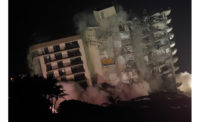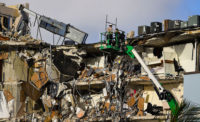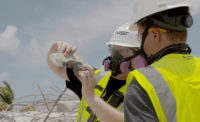In the four long days since North Miami Beach, Fla., ordered the evacuation of Crestview Towers, an apartment tower roughly six miles from Champlain Towers South, the reason for a delay in submitting the condominium's engineering inspection has been a nagging question.
Completed in January as part of Crestview Tower's response to the required 40-year recertification process—but not submitted to town officials until July 1—the inspection report deemed the 10-story, concrete structure with a slab-on-grade foundation, and its electrical system, unsafe for occupancy. North Miami Beach officials ordered dismayed residents to evacuate on July 3.
But within days, the 156-unit condominium's board had carried out another inspection and on July 6 submitted it to the town. This inspection, said the condominium's attorney, found the building safe for occupancy during whatever repairs are needed.
The entire matter almost certainly will focus attention on engineering inspection reports, and more specifically, the interpretation of cracks and spalling in reinforced concrete buildings with flat slabs like Champlain Towers in nearby Surfside, Fla. As it stands now, the one prepared for Crestview Towers in January is notably brief and seemingly based on visual inspection alone. There is no reason to believe it is different from others prepared for buildings in the area.
Gustavo Parra-Montesinos, a research engineer and professor of structural engineering at the University of Wisconsin-Madison contacted by ENR, said after a short review of the inspection report: "There's not much information in it."
The January assessment of the building's condition came at the same time that the condominium, like others in the area, sought to finance recent hurricane damage repairs to the building. Crestview Towers is currently mediating a disputed claim and lawsuit with Liberty Surplus Insurance Corp. for damage sustained by the building in September, 2017, from Hurricane Irma, according to federal court records. The insurer initially rejected the claims as being made too late, confusion about where the damage occurred and problems in gaining access to the apartments.
The January Crestview Towers Inspection
Crestview Towers' overall engineering inspection report in January was conducted by professional engineer Roberto Berreiro, and another licensed engineer carried out the actual structural evaluation, according to stamps on the report.
Spalling plagued numerous areas of the building, including concrete columns and beams, an overhead garage slab, balcony and at all emergency stairwells, the report stated. Corroding steel also was cited as a big problem.
The structure's general alignment was rated fair, and the section on cracks, in which the report specified various degrees of crack seriousness (hairline, fine, medium and wide), said simply "cracks observed" and "spalled concrete and rebar corrosion observed."
Barreiro did not reply to email and phone requests for comment.
A deeper understanding of the observed defects would require a review of the building's design, said Parra-Montesinos. As a researcher, he says he ideally would want to know more about the location of any observed cracks and their alignment as well as the dimensions. "It also depends on what reinforcement you have inside" the concrete, he adds.
A meaningful evaluation, Parra-Montesinos adds, would ask how close to the building code limits the building was designed, in order to know if there was unused capacity in the structure or its connections.
Whether the brief engineering inspection report format will be applied to all other area structures now is unclear.
The Crestview Towers association submitted its new engineering inspection report to North Miami Beach officials at 12 pm July 6. According to attorney Mariel Tollinchi, representing the owners association, the new report allows the immediate return of the residents.
Engineers retained by the association carried out the new report's structural evaluation over a full day, from 10 am until 9 pm or so, says Tollinchi. No destructive testing was performed and "none of the covered structural members could be visually inspected," she says.
“What the report says is that repairs need to be made, and there’s no reason the repairs can’t be made with the residents back in the building," Tollinchi says. "The integrity of the building does not pose a threat to the residents.”
Calls for Expanding Inspections
The call for heightened scrutiny of the state's multifamily buildings was spurred by the catastrophic Champlain Towers South collapse.
As of July 7, officials had confirmed that 46 people have died, with another 94 still missing, as a result of the June 24 partial collapse of the 40-year-old, 12-story condominium in Surfside, Fla. The same day, the search-and-rescue effort officially transitioned to a recovery operation, according to reports.
Statewide, numerous groups are urgently calling for more extensive and frequent safety inspections, especially in older buildings. Miami-Dade County Mayor Daniella Levine Cava, who ordered an audit of inspections performed for buildings in unincorporated Miami-Dade County for purposes of the 40-year recertification process, posted on Twitter that she wants “municipalities to do their own aggressive review.”
For Miami-Dade’s effort, the county’s Dept. of Regulatory and Economic Resources (RER) is auditing its inventory of pending recertification. The department is “prioritizing the status of multifamily apartments and condominiums" to ensure compliance milestones are met and that repairs are made according to recommendations of the engineer providing the recertification report”
According to the county, approximately 318 multifamily residential buildings are in the midst of recertification. Additionally, of 469 current enforcement cases in the county’s Unsafe Structures process, RER has identified 24 cases involving buildings four stories or higher and prioritized those for inspection.
Some officials outside of Miami-Dade County indicate they may be following Levine Cava's suggestion for developing more aggressive reviews of multifamily buildings.
In West Palm Beach, the county seat of Palm Beach County, Mayor Keith A. James has directed staff “to evaluate the viability of a 40-Year Building Safety Inspection Program for the City of West Palm Beach for future consideration,” according to a statement.
“Along with other jurisdictions in Palm Beach County, we are working with League of Cities to establish a countywide recertification program for older buildings,” added Kathleen Walters, communications officer for West Palm Beach.







Post a comment to this article
Report Abusive Comment